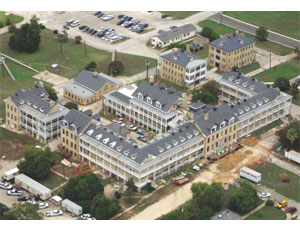About two dozen buildings at Fort Sam Houston, some dating back almost as early as the post’s 1876 origin, are being transformed into modern, energy-efficient offices, barracks and other facilities for military personnel and federal employees.
The work is part of the $3 billion in Base Realignment and Closure and other construction programs ongoing at military installations in San Antonio.

“Fort Sam Houston has the most historic structures on an active military installation, so our program is renovating buildings,” says Randy Holman, program manager with the Army Corps of Engineers and spokesperson for the Joint Program Management Office, the tri-service military organization that is overseeing design and construction. “The oldest structure I am aware of was built in 1891, so we’re touching points of the post that were built not too long after the post was founded.”
The building 600 area, the old infantry post that housed original troops, is constructed of wood and masonry exterior walls and features interesting architectural elements such as parapets, horse ties, watering troughs and a sally port (a gate or passage in a fortified place for use by troops making a sortie), Holman says.
Renovations also include Spanish colonial-style buildings that share many design and construction features, including verandas with wrap-around porches, columns and huge windows.
The historic renovations represent more than 1 million sq ft of the overall 10-million-sq-ft program, which includes building and renovating 78 major facilities.
“We plan to house at the end of the program as many as 3,000 military and civilian personnel in the renovated structures, roughly 25% of the flow of people coming to San Antonio,” says Brian Dwyer, senior public affairs specialist with Parsons Corp., Pasadena, Calif., which is serving as architect engineer integrator and overseeing design and construction/renovation efforts.
Although the historic renovations are not the largest and most complicated piece of the overall program, they required a lot of planning and coordination with the Texas Historical Commission, the Advisory Council on Historic Preservation and compliance with the National Historic Preservation Act.
BRAC was authorized by Congress in 2005 and the JPMO began working on a business plan and sequencing in 2006, before contracts were awarded. “By the time our design effort started, most of the historic homework had been accomplished,” Holman says. The first contract was awarded in 2007.
“Early in the program, we relied on U.S. Army Garrison Fort Sam Houston and their staff to bring the right stakeholders to the table,” Holman adds. He says the ongoing partnership has been fruitful in facilitating communication and coordination when problems arise and helping maintain the schedule and budget.
Renovating old structures, bringing them up to modern codes and meeting the military’s standard for LEED-silver certification posed unique challenges for each structure, depending on its original construction and new, intended use, Holman says. In most cases, renovations required replacing interior partitions, electrical wiring, plumbing, climate-control systems and lighting. Wooden floors, doors, windows, stairways and ceilings needed to be repaired and refinished. Structural supports also needed repair and/or beefing up.
“We are looking for a modern solution to historical architecture,” Holman says. Some things are routine and others require special skills and numerous consultations with the military advisory council and THC, he adds.
“In some of the buildings, we have>>maintained some elements, like the original vestibule to the hospital, which included a full restoration of the wood-carved ceiling, including research to develop the right...


Post a comment to this article
Report Abusive Comment